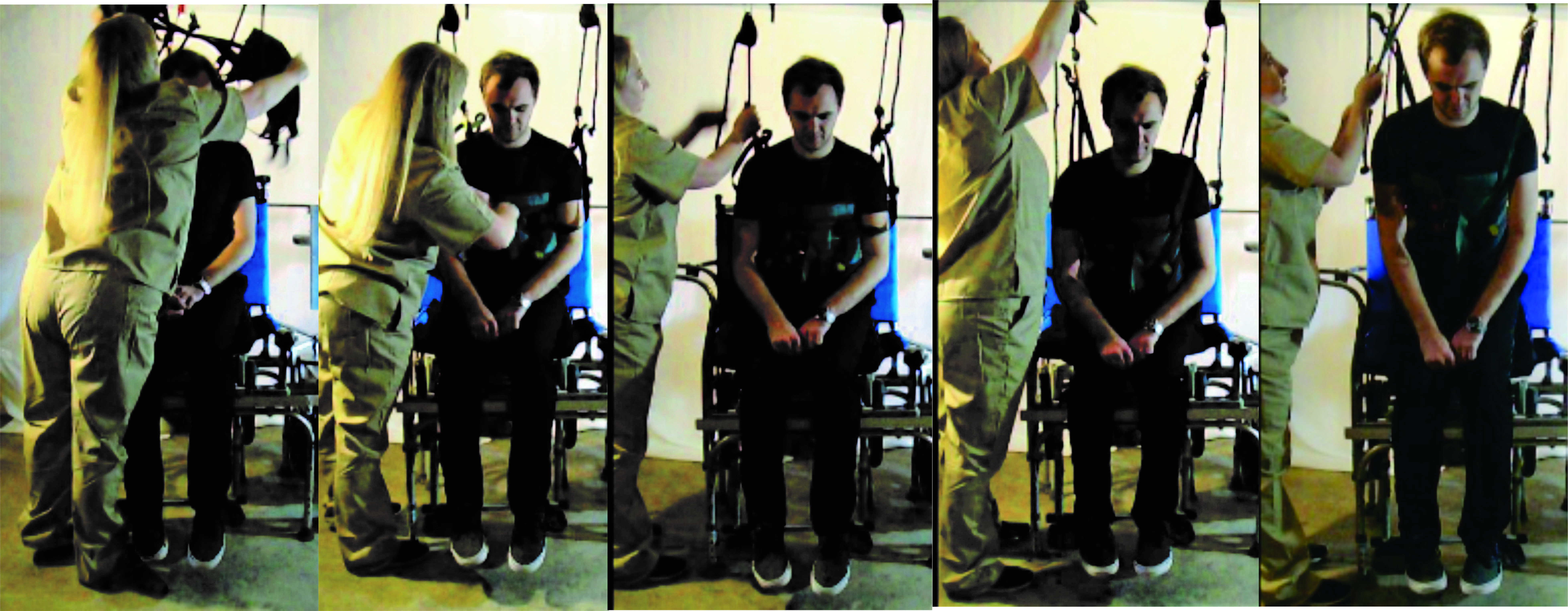

Put on Vest
Tighten Ropes
Pull Levers (Raise Person to Transfer)

|

Put on Vest
Tighten Ropes
Pull Levers (Raise Person to Transfer)
|
With respect to caregiver stress during transfer, pulling the lever induces
minimal stress since caregivers can optionally grab the lever
rope and bend at
the knees letting their own weigh lift the patient. Thus the arms, hands,
hips, and shoulders are subject to very little stress when pulling the levers
to hoist the person. Caregivers may be able to transfer persons two
times their weight
(see Device demonstration video)
with minimal stress or strain
using the device.

Below is the upper assembly that shows how the upper lever mechanism attaches to the eye screw that screws into a 2x6 or 2x8 ceiling beam (see illustration). Note that two eye screws can be used side-by-side (in tandem) with a bolt connecting them for heavier persons for added safety. In Version 2.0, the red square "extender" tube is eliminated. 
Here is the position of the device when the person is fully raised: 
Here is the position of the device when the person is raised half the six inch distance (not a common position during transfer): 
The following picture shows how a common vest (sometimes referred to as a gait training vest) often used by people with limited mobility attaches to the device. Our example uses a LIKO(TM) "MasterVest" which allows people to be raised from a sitting postion but for brief periods of time (perhaps 10 - 15 seconds). Toileting slings could also be used but they are more complex and slower to wrap. They can offer more support for the person's torso and put less stress on the disabled person's chest and armpits.
The most common transfer method associated with slings bends the person's body into a semi-fetal position and compresses their chest and hips for minutes at a time. It is therefore more invasive than the Aging-At-Home method.

The Aging-At-Home device is compact not only when in use but also when it is not needed. The picture below shows how the device can be stored six feet or more above the floor so it does not interfere with the use of the room when the device is not in use. Note that the most transfer devices (sling or sit-to-stand lifts) are large four-wheeled floor devices, and are quite heavy and bulky. So this compact design has many advantages.
Disclaimer: Aging-At-Home.org claims no medical or engineering expertise, and seeks only to share information we have found useful with others. Any use of the information provided is up to others, and we assume no liability for such use. This website is for information purposes only. This information is not provided for the purpose of diagnosing, treating, mitigating, or preventing any type of disease, disability, or medical condition.
There are two versions of the device, V1.0 and V2.0. V2.0 is simpler with fewer parts and build steps but their differences are minimal and they both operate the same. In addition, V2.0 has two "how to" videos which make construction easier.
To continue, click on the [ NEXT ] link below:
|
|
Home Copyright © 2022, Towersgreen, LLC, All Rights Reserved |
|